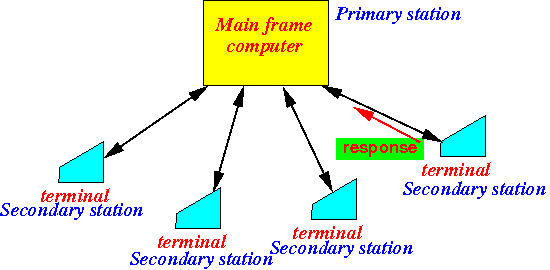- The origin of the
HDLC protocol:
- HDLC
was originally designed
to connect one (main frame) computer
to
multiple peripherals:

- HDLC
was originally designed
to connect one (main frame) computer
to
multiple peripherals:
- Terminology:
- Primary station =
an "intelligent" device
- A Primary station is usually a computer
- Secondary station =
a supporting device
- A Secondary station
is usually a
peripheral device
- Example: termimal, printer, etc.
- A Secondary station
is usually a
peripheral device
- Primary station =
an "intelligent" device
- Master-slave protocol:
- Master-slave protocol =
a model of
communication
where one device
(or process)
has control
over the other devices.
- The controlling device
is called: the master
- The other devices are called slaves
- Master-slave protocol =
a model of
communication
where one device
(or process)
has control
over the other devices.
- Operation of
a master-slave protocol:
- The master device (= computer)
controls every step of
the communication !!!
- A slave device can only transmit if the master device has given permission to the slave device to do so !!!
- The master device (= computer)
controls every step of
the communication !!!
- The original HDLC
datalink protocol is
known as:
- The Normal Response Mode (NRM)
- NRM:
- The NRM of
HDLC is:
- A master-slave protocol
- The primary station is the master
- The secondary stations are slaves
- A master-slave protocol
- The NRM of
HDLC is:
- Operation of the
NRM protocol:
-
The primary (= main frame computer)
first sends a
poll frame
to a secondary (= terminal):

- In response to
the poll,
the secondary (= terminal)
will send some
data back to
the primary:

-
The primary (= main frame computer)
first sends a
poll frame
to a secondary (= terminal):
- Later, the HDLC
is updated with
a new operational mode called:
- Asynchronous Balanced Mode (ABM)
- Asynchronous Balanced Mode (ABM)
- The ABM protocol is
defined for:
- a combine station
- Combined station:
- Combined station =
a station that can
operate as:
- a primary station (= takes control) and
- a secondary station (= process commands)
- Combined station =
a station that can
operate as:
- Operation of the
ABM protocol:
- In the ABM mode,
either device can
send a request to the
other device:

-
The
station
that receives
a request
will later send a response:

- In the ABM mode,
either device can
send a request to the
other device:
- Fact:
- The ABM protocol is a popular data link protocol for long haul links:
- Wikipedia page: click here